Coordinated Regulation of Iron-Acquisition Genes and Citrate Biosynthesis Drives Seasonal Iron Deficiency Adaptation in ‘Yali’ Pears (Pyrus bretschneideri Rehd.)
Abstract
1. Introduction
2. Materials and Methods
2.1. Plant Materials and Growth Conditions
2.2. SPAD (Soil and Plant Analyzer Development) Measurement
2.3. Chlorophyll Fluorescence Measurement
2.4. Soil Property Analysis
2.5. Root Vitality Measurement
2.6. Ferric-Chelate Reductase (FCR) Enzyme Activity Measurement
2.7. Total and Active Iron Measurement in Leaves
2.8. Measurement of Citrate in New Roots and Leaves
2.9. qRT-PCR Analysis
2.10. Statistical Analysis
3. Results
3.1. Physicochemical Properties of Soil
3.2. Correlation Between Different Chlorosis Levels and Iron Content
3.3. Correlation Between Different Chlorosis Levels and Relative Chlorophyll Content and Chlorophyll Fluorescence Parameters
3.4. Correlation Between Different Chlorosis Levels and Root Iron Uptake Ability
3.5. Effect of Different Chlorosis Levels and Citrate Content
3.6. Correlation Between Different Chlorosis Levels and the Expression of Iron Uptake-Related Genes
3.7. Multivariate Analysis of Physiological Traits and Gene Expression
3.7.1. PCA of Physiological Traits and Gene Expression
3.7.2. VIP Analysis of Key Variables Contributing to Chlorosis and Iron Deficiency Responses
3.7.3. Correlation Analysis Between Physiological Traits and Gene Expression
4. Discussion and Conclusions
Author Contributions
Funding
Data Availability Statement
Conflicts of Interest
References
- Merry, R.; Dobbels, A.A.; Sadok, W.; Naeve, S.; Stupar, R.M.; Lorenz, A.J. Iron Deficiency in Soybean. Crop Sci. 2022, 62, 36–52. [Google Scholar] [CrossRef]
- Zebec, V.; Lisjak, M.; Jović, J.; Kujundžić, T.; Rastija, D.; Lončarić, Z. Vineyard Fertilization Management for Iron Deficiency and Chlorosis Prevention on Carbonate Soil. Horticulturae 2021, 7, 285. [Google Scholar] [CrossRef]
- Zang, Y.; Huang, Y.; Chang, X.; Chen, J.; Jiang, T.; Wu, Z.; Lu, L.; Tian, S. High Soil pH and Plastic-Shed Lead to Iron Deficiency and Chlorosis of Citrus in Coastal Saline–Alkali Lands: A Field Study in Xiangshan County. Horticulturae 2023, 9, 437. [Google Scholar] [CrossRef]
- Kudirka, G.; Viršilė, A.; Sutulienė, R.; Laužikė, K.; Samuolienė, G. Precise Management of Hydroponic Nutrient Solution pH: The Effects of Minor pH Changes and Mes Buffer Molarity on Lettuce Physiological Properties. Horticulturae 2023, 9, 837. [Google Scholar] [CrossRef]
- Guo, G.; Xiao, J.; Jeong, B.R. Iron Source and Medium pH Affect Nutrient Uptake and Pigment Content in Petunia Hybrida ‘Madness Red’ Cultured in Vitro. Int. J. Mol. Sci. 2022, 23, 8943. [Google Scholar] [CrossRef] [PubMed]
- Zhang, Y.; Liu, W.-J.; Cheng, X.-H.; Du, G.-Q.; Zhang, Y.-X. Effects of Pollinizer Cultivars on the Morphogenesis and Development of Yatu and the Endogenous Hormone Content in the Base of Young Fruit Of’yali’pear (Pyrus Bretschneideri Rehd.). J. Fruit Sci. 2020, 37, 1168–1174. [Google Scholar] [CrossRef]
- Ren, Z.-Y.; Cheng, Y.-D.; Guan, Y.-Q.; Yang, X.-Z.; Guan, J.-F. Detection of Freshness and Damage Degree of Pyrus Bretschneideri Rehd. Based on Electronic Nose. J. Food Saf. Qual. 2022, 13, 2770–2777. [Google Scholar]
- Li, J.; Cao, X.; Jia, X.; Liu, L.; Cao, H.; Qin, W.; Li, M. Iron Deficiency Leads to Chlorosis through Impacting Chlorophyll Synthesis and Nitrogen Metabolism in Areca catechu L. Front. Plant Sci. 2021, 12, 710093. [Google Scholar] [CrossRef] [PubMed]
- Rahimi, S.; Talebi, M.; Baninasab, B.; Gholami, M.; Zarei, M.; Shariatmadari, H. The Role of Plant Growth-Promoting Rhizobacteria (Pgpr) in Improving Iron Acquisition by Altering Physiological and Molecular Responses in Quince Seedlings. Plant Physiol. Biochem. 2020, 155, 406–415. [Google Scholar] [CrossRef]
- Martín-Barranco, A.; Spielmann, J.; Dubeaux, G.; Vert, G.; Zelazny, E. Dynamic Control of the High-Affinity Iron Uptake Complex in Root Epidermal Cells1. Plant Physiol. 2020, 184, 1236–1250. [Google Scholar] [CrossRef]
- Dubeaux, G.; Neveu, J.; Zelazny, E.; Vert, G. Metal Sensing by the Irt1 Transporter-Receptor Orchestrates Its Own Degradation and Plant Metal Nutrition. Mol. Cell 2018, 69, 953–964.e5. [Google Scholar] [CrossRef] [PubMed]
- Han, D.-G.; Shi, Y.; Wang, B.; Liu, W.; Yu, Z.-Y.; Lv, B.-Y.; Yang, G.-H. Isolation and Preliminary Functional Analysis of Mxcs2: A Gene Encoding a Citrate Synthase in Malus Xiaojinensis. Plant Mol. Biol. Report. 2014, 33, 133–142. [Google Scholar] [CrossRef]
- Wang, Y.; Kang, Y.; Zhong, M.; Zhang, L.; Chai, X.; Jiang, X.; Yang, X.J.A. Effects of Iron Deficiency Stress on Plant Growth and Quality in Flowering Chinese Cabbage and Its Adaptive Response. Agronomy 2022, 12, 875. [Google Scholar] [CrossRef]
- Lucena, J.J.; Hernandez-Apaolaza, L. Iron Nutrition in Plants: An Overview. Plant Soil 2017, 418, 1–4. [Google Scholar] [CrossRef]
- Thomas, G.W. Soil pH and soil acidity. In Methods of Soil Analysis: Part 3 Chemical Methods 5; John Wiley & Sons: Hoboken, NJ, USA, 1996; pp. 475–490. [Google Scholar]
- Ma, Y.; Li, J.; Tian, M.; Liu, Y.; Wei, A. Authentication of Chinese Prickly Ash by Its2 Sequencing and the Influence of Environmental Factors on Pericarp Quality Traits. Ind. Crops Prod. 2020, 155, 112770. [Google Scholar] [CrossRef]
- Shidan, B. Soil Agrochemical Analysis, 3rd ed.; Agriculture Press: Beijing, China, 2000. [Google Scholar]
- Lv, X.; Kong, H.; Luo, Y.; Dong, D.; Liu, W.; Wu, D.; Ye, Z.; Ma, J.; Liu, D. The Impact of Magnesium on the Growth, Physiology and Quality of Tea (Camellia sinensis L.) Plants under Acid Stress. Agronomy 2024, 14, 767. [Google Scholar] [CrossRef]
- Zhou, J.; Yuan, W.; Di, B.; Zhang, G.; Zhu, J.; Zhou, P.; Ding, T.; Qian, J. Relationship among Electrical Signals, Chlorophyll Fluorescence, and Root Vitality of Strawberry Seedlings under Drought Stress. Agronomy 2022, 12, 1428. [Google Scholar] [CrossRef]
- Zheng, S.J.; Tang, C.; Arakawa, Y.; Masaoka, Y. The Responses of Red Clover (Trifolium pratense L.) to Iron Deficiency: A Root Fe(Iii) Chelate Reductase. Plant Sci. 2003, 164, 679–687. [Google Scholar] [CrossRef]
- Lin, L.; Li, Z.; Wu, C.; Xu, Y.; Wang, J.; Lv, X.; Xia, H.; Liang, D.; Huang, Z.; Tang, Y. Melatonin Promotes Iron Reactivation and Reutilization in Peach Plants under Iron Deficiency. Int. J. Mol. Sci. 2023, 24, 16133. [Google Scholar] [CrossRef]
- Lucarini, M.; Di Lullo, G.; Cappelloni, M.; Lombardi-Boccia, G. In Vitro Estimation of Iron and Zinc Dialysability from Vegetables and Composite Dishes Commonly Consumed in Italy: Effect of Red Wine. Food Chem. 2000, 70, 39–44. [Google Scholar] [CrossRef]
- Zhang, C.; Wang, Y.; Li, Y. Effect of Iron Deficiency on Contents of Nutrient Elements and Photosynthetic Characteristic of Leaves in Pear Trees. J. Northwest For. Univ. 2002, 17, 9–11. [Google Scholar]
- Zhang, R.; Yang, P.; Liu, S.; Wang, C.; Liu, J. Evaluation of the Methods for Estimating Leaf Chlorophyll Content with Spad Chlorophyll Meters. Remote Sens. 2022, 14, 5144. [Google Scholar] [CrossRef]
- Zhao, J. Photosynthetic Characteristics Research and Fruit Quality Determination of Different Planting Density on Korla Fragrant Pear. Master’s Thesis, Xinjiang Agricultural University, Urumqi, China, 2014. (In Chinese). [Google Scholar]
- Nsiri, K.; Krouma, A. The Key Physiological and Biochemical Traits Underlying Common Bean (Phaseolus vulgaris L.) Response to Iron Deficiency, and Related Interrelationships. Agronomy 2023, 13, 2148. [Google Scholar] [CrossRef]
- Rewald, B.; Meinen, C. Plant Roots and Spectroscopic Methods—Analyzing Species, Biomass and Vitality. Front. Plant Sci. 2013, 4, 393. [Google Scholar] [CrossRef]
- Li, X. The Response Mechanism of Pyrus Betulifolia Root System to Iron Deficiency Stress and the Expression Analysis of Related Resistance Genes. Ph.D. Thesis, Hebei Agricultural University, Baoding, China, 2016. (In Chinese). [Google Scholar]
- Tahjib-Ul-Arif, M.; Zahan, M.I.; Karim, M.M.; Imran, S.; Hunter, C.T.; Islam, M.S.; Mia, M.A.; Hannan, M.A.; Rhaman, M.S.; Hossain, M.A.; et al. Citric Acid-Mediated Abiotic Stress Tolerance in Plants. Int. J. Mol. Sci. 2021, 22, 7235. [Google Scholar] [CrossRef]
- Kong, W.-L.; Wu, X.-Q.; Zhao, Y.-J. Effects of Rahnella Aquatilis Jz-Gx1 on Treat Chlorosis Induced by Iron Deficiency in Cinnamomum Camphora. J. Plant Growth Regul. 2019, 39, 877–887. [Google Scholar] [CrossRef]
- Bityutskii, N.P.; Yakkonen, K.L.; Lukina, K.A.; Semenov, K.N. Fullerenol Increases Effectiveness of Foliar Iron Fertilization in Iron-Deficient Cucumber. PLoS ONE 2020, 15, e0232765. [Google Scholar] [CrossRef] [PubMed]
- Gao, Z.; Zhao, C.; Dong, D.; Liu, S.; Wen, X.; Gu, Y.; Jiao, L. Visualizing Changes of Metabolites During Iron Deficiency Chlorosis in Field-Grown Pear Leaves Using Micro-Raman Spectral Imaging. Front. Plant Sci. 2022, 13, 1079660. [Google Scholar] [CrossRef]
- Gong, Q.; Zhou, M.; Li, X.; Guo, Y. Transcription Factor Myb8 Regulates Iron Deficiency Stress Response in Arabidopsis. Plant Sci. 2024, 340, 111973. [Google Scholar] [CrossRef]
- Zhang, X.; Wei, X.; Ali, M.M.; Rizwan, H.M.; Li, B.; Li, H.; Jia, K.; Yang, X.; Ma, S.; Li, S.; et al. Changes in the Content of Organic Acids and Expression Analysis of Citric Acid Accumulation-Related Genes During Fruit Development of Yellow (Passiflora edulis f. flavicarpa) and Purple (Passiflora edulis f. edulis) Passion Fruits. Int. J. Mol. Sci. 2021, 22, 5765. [Google Scholar] [CrossRef]
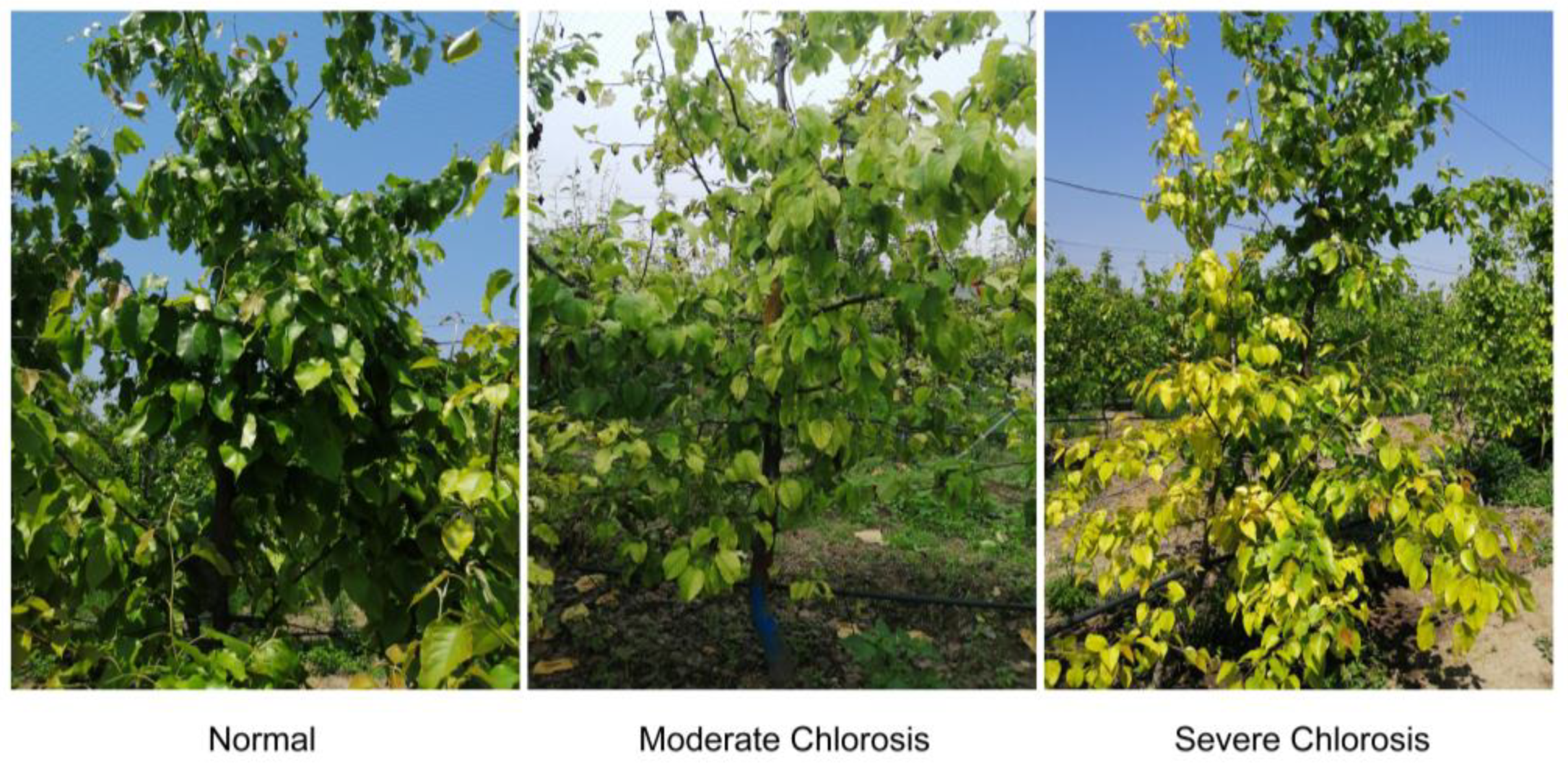
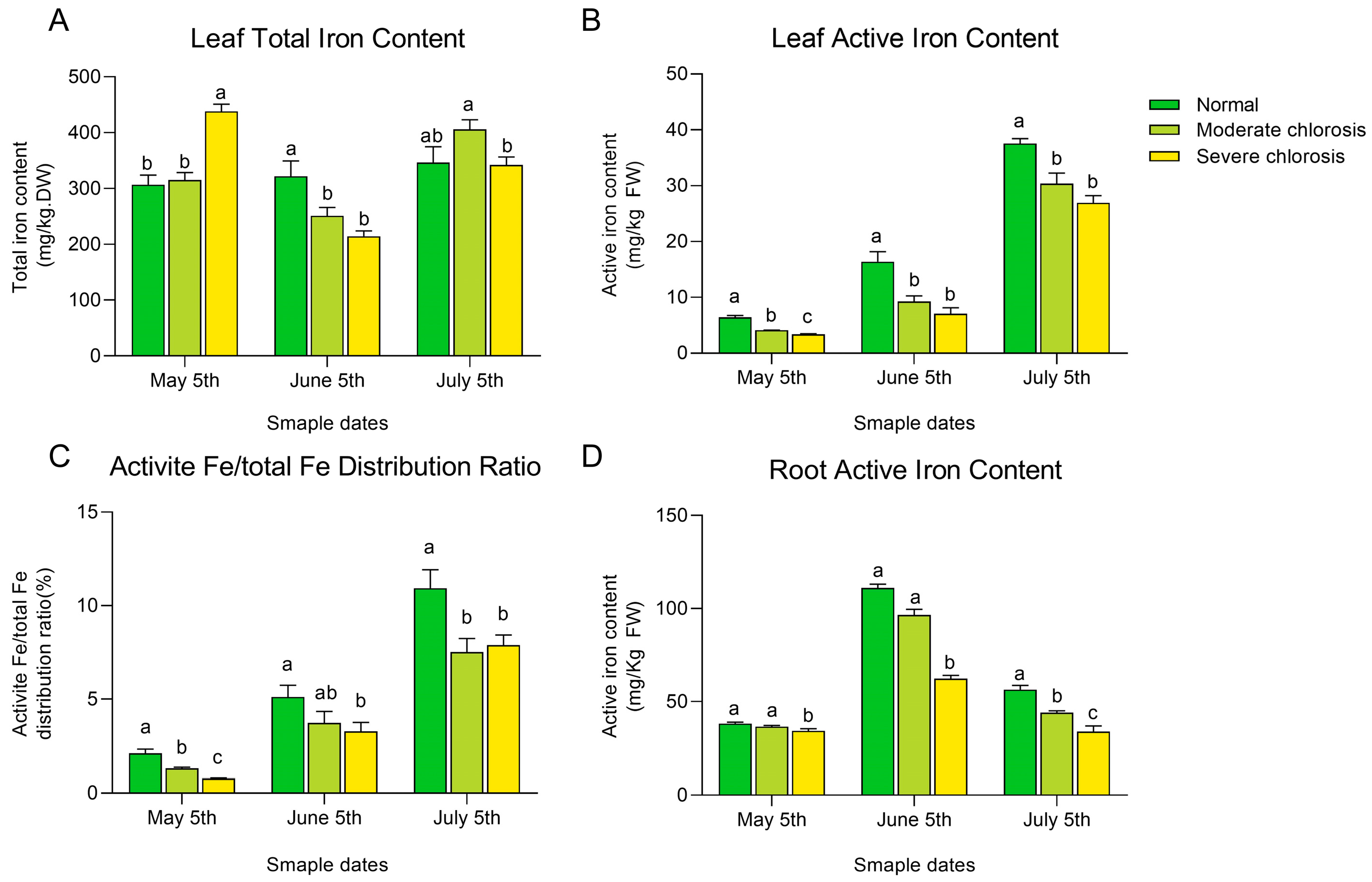
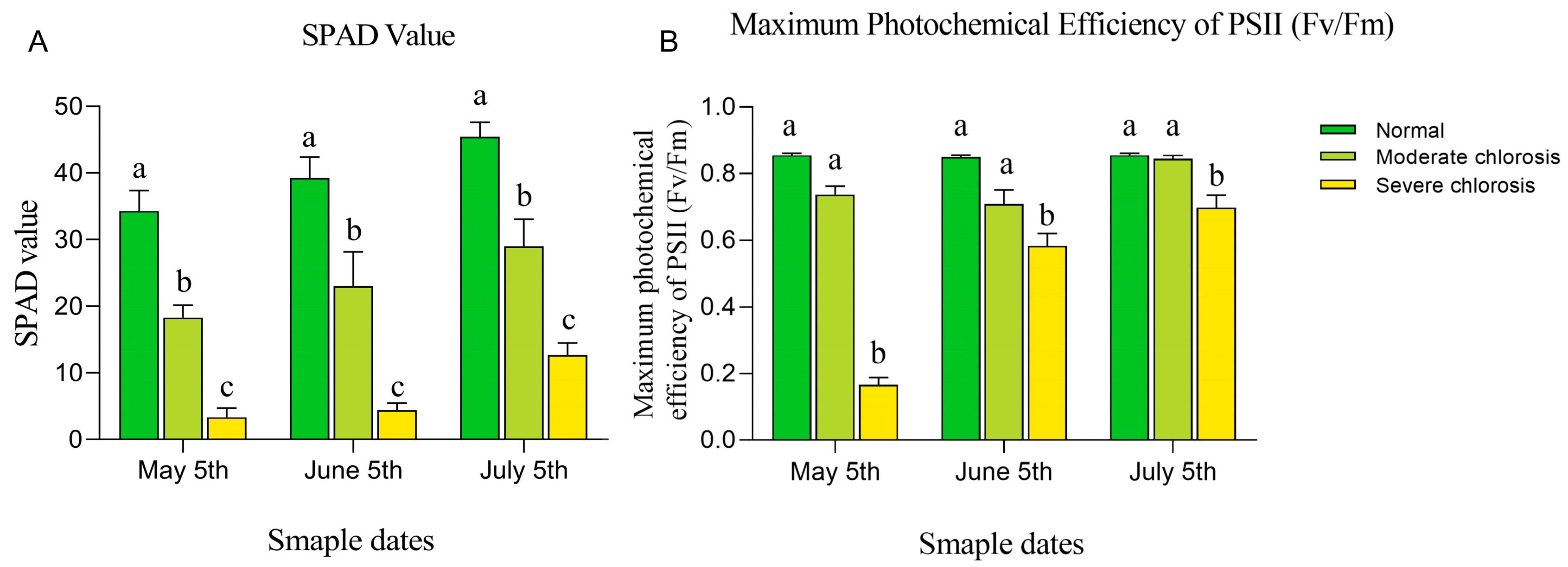


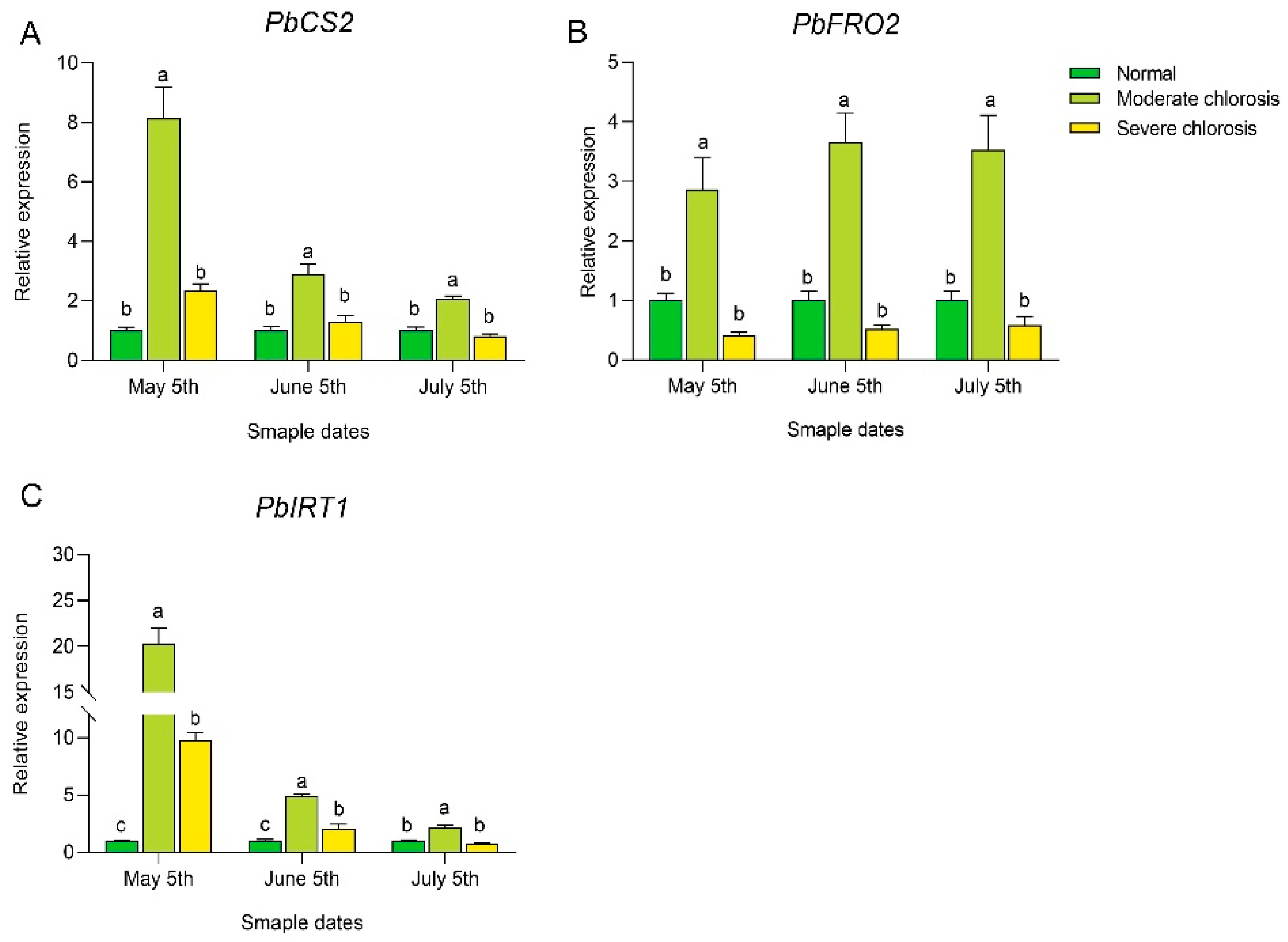

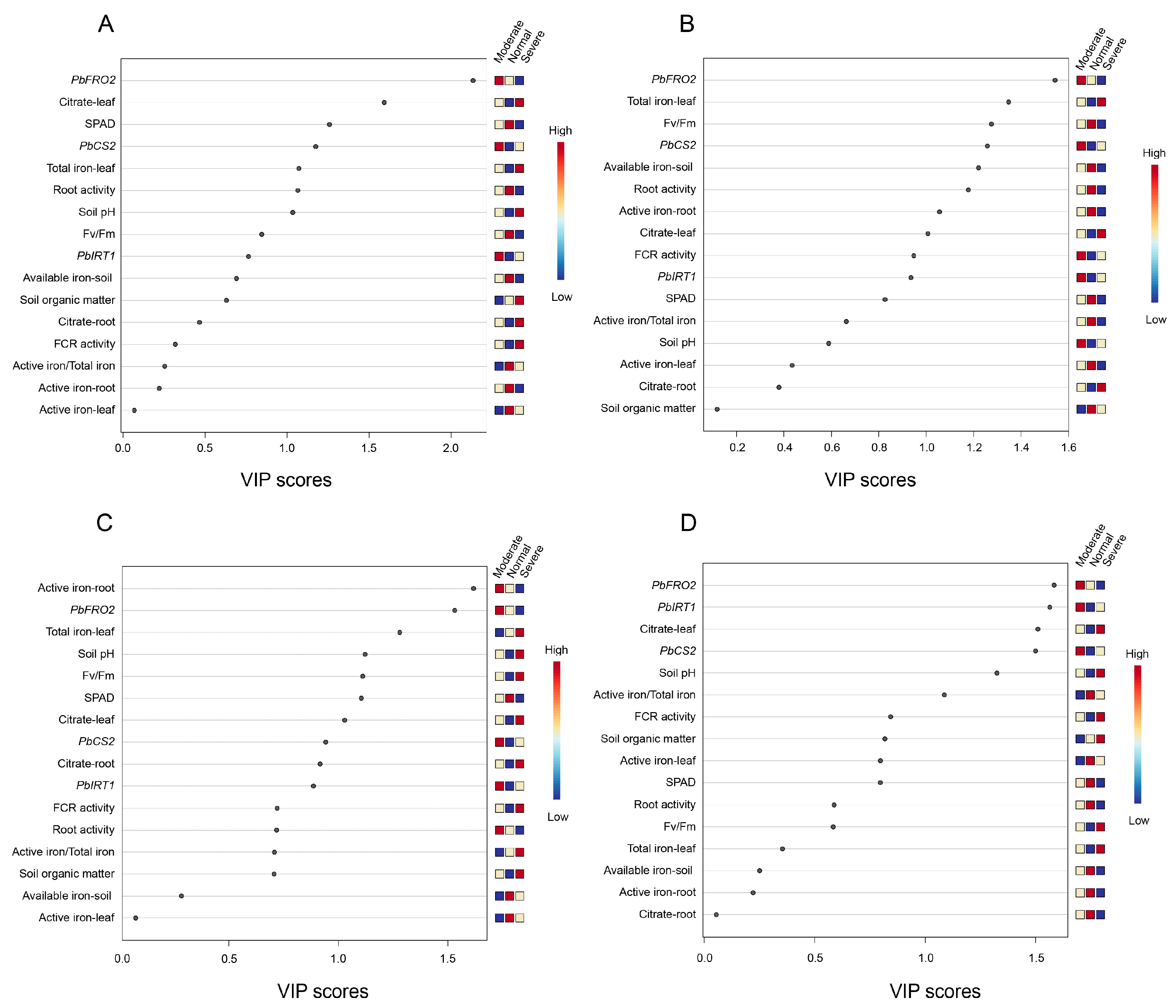
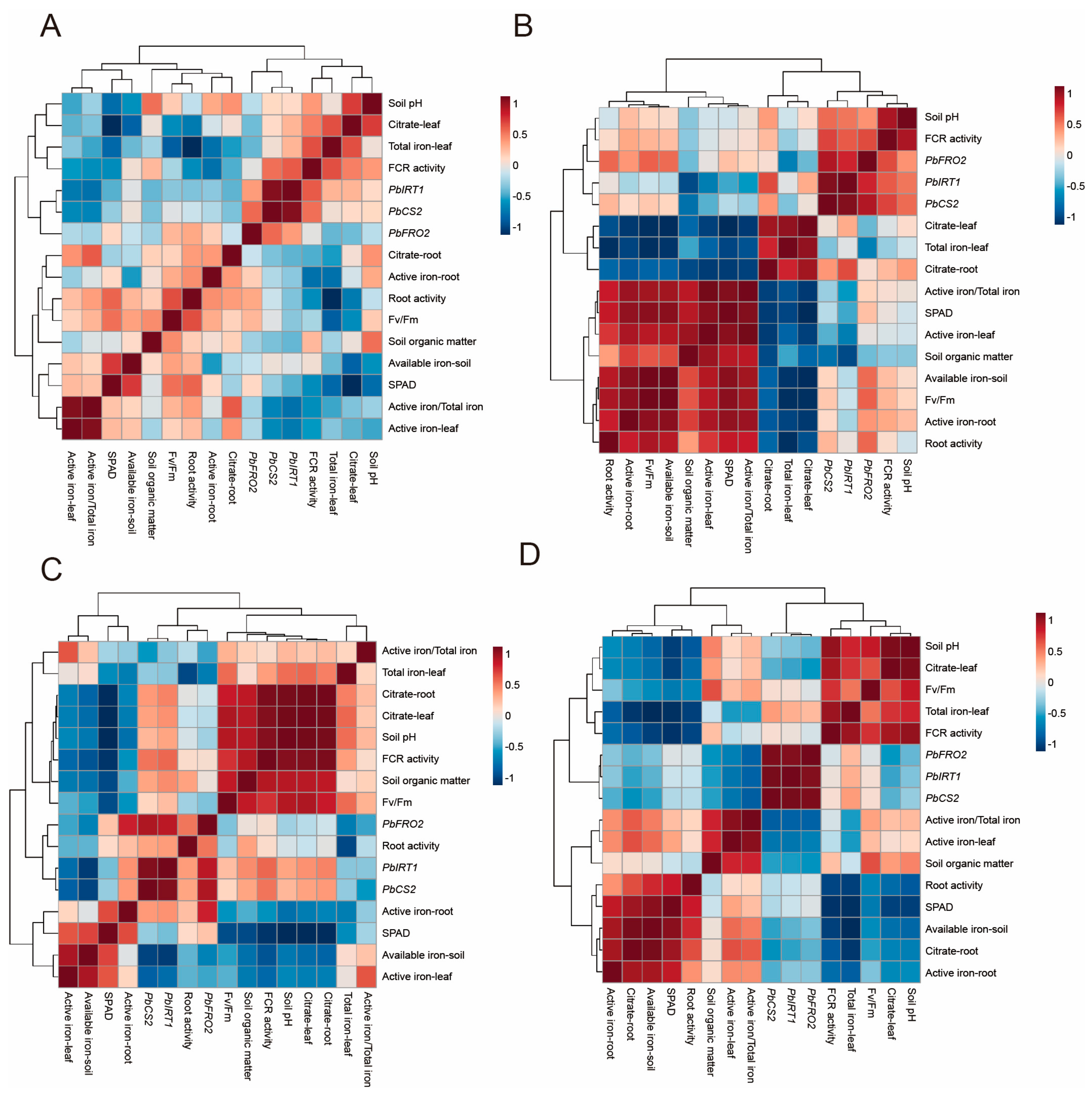
| Gene | Primer Sequences | |
|---|---|---|
| PbACT | qPbAcT-F | 5′-TTGGTATGGGTCAGAAGG-3′ |
| qPbAcT-R | 5′-CTGTGAGCAGAACTGGGTG-3′ | |
| PbFRO2 | qPbFRO2-F | 5′-GCGGAGGAAGCGGTATTA-3′ |
| qPbFRO2-R | 5′-CCGAAACGGGAAGGATTA-3′ | |
| PbIRT1 | qPbIRT1-F | 5′-AGTCTGAGGAGGACGAGTGC-3′ |
| qPbIRT1-R | 5′-GGAACGAGTGACAAGAGGGA-3′ | |
| PbCS2 | qPbCS2-F | 5′-GGCGAGAGAAAGAGAGGTGATC-3′ |
| qPbCS2-R | 5′-CGGTGACGCTCCTGAAGAATAC-3′ | |
| Sample Dates | Chlorisis Types | Soil pH Value | Soil Active Iron (mg· kg−1) | Organic Matter Content (mg· kg−1) |
|---|---|---|---|---|
| 5 May | Normal | 7.41 ± 0.04 c | 35.2 ± 1.52 a | 26.37 ± 1.30 a |
| Moderate chlorosis | 7.76 ± 0.05 b | 29.05 ± 1.39 b | 18.34 ± 0.86 b | |
| Severe chlorosis | 7.86 ± 0.05 a | 7.99 ± 0.15 c | 19.95 ± 0.56 b | |
| 5 June | Normal | 7.63 ± 0.01 b | 20.11 ± 1.17 a | 21.10 ± 1.62 a |
| Moderate chlorosis | 7.91 ± 0.02 a | 7.88 ± 0.10 b | 21.09 ± 2.13 a | |
| Severe chlorosis | 8.00 ± 0.05 a | 6.94 ± 0.16 b | 18.11 ± 0.86 a | |
| 5 July | Normal | 7.78 ± 0.06 b | 52.85 ± 0.50 a | 26.60 ± 0.65 a |
| Moderate chlorosis | 7.92 ± 0.07 a | 22.29 ± 0.82 b | 23.62 ± 2.53 ab | |
| Severe chlorosis | 8.04 ± 0.02 a | 14.02 ± 0.78 c | 20.87 ± 0.32 b |
| May to July | May | ||||||
|---|---|---|---|---|---|---|---|
| Physiological /Molecular Indicators | PC1 Loadings | Physiological /Molecular Indicators | PC2 Loadings | Physiological /Molecular Indicators | PC1 Loadings | Physiological /Molecular Indicators | PC2 Loadings |
| Total iron-leaf | -0.354 | PbCS2 | 0.371 | SPAD | −0.320 | PbCS2 | −0.452 |
| SPAD | 0.329 | Citrate-root | −0.333 | Citrate-leaf | 0.318 | PbIRT1 | −0.424 |
| Citrate -leaf | −0.325 | PbIRT1 | 0.329 | Active iron/Total iron | −0.312 | PbFRO2 | −0.420 |
| Root activity | 0.325 | Available iron-soil | 0.323 | Available iron-soil | −0.308 | FCR activity | −0.372 |
| FCR activity | −0.317 | Citrate -leaf | −0.319 | Fv/Fm | −0.305 | Soil pH | −0.315 |
| Active iron/Total iron | 0.294 | PbFRO2 | 0.309 | Active iron-leaf | −0.304 | Soil organic matter | 0.270 |
| PbIRT1 | −0.282 | SPAD | 0.294 | Active iron-root | −0.302 | Total iron-leaf | 0.171 |
| Active iron-leaf | 0.269 | Soil pH | −0.279 | Total iron-leaf | 0.292 | Citrate-root | −0.159 |
| Fv/Fm | 0.255 | Active iron/Total iron | −0.244 | Citrate-root | 0.292 | Fv/Fm | −0.136 |
| PbCS2 | −0.208 | Active iron-leaf | −0.175 | Root activity | −0.268 | Root activity | −0.132 |
| Available iron-soil | 0.176 | Soil organic matter | −0.147 | Soil organic matter | −0.247 | Active iron-leaf | 0.119 |
| Citrate-root | 0.164 | Active iron-root | −0.139 | PbIRT1 | 0.120 | Available iron-soil | −0.111 |
| Soil pH | −0.158 | FCR activity | 0.116 | PbFRO2 | −0.089 | Active iron-root | −0.097 |
| Active iron-root | 0.147 | Fv/Fm | 0.111 | PbCS2 | 0.032 | Active iron/Total iron | 0.044 |
| Soil organic matter | 0.045 | Root activity | 0.105 | FCR activity | −0.020 | SPAD | 0.029 |
| PbFRO2 | 0.031 | Total iron-leaf | −0.095 | Soil pH | 0.014 | Citrate-leaf | 0.022 |
| June | July | ||||||
| Physiological /Molecular Indicators | PC1 Loadings | Physiological /Molecular Indicators | PC2 Loadings | Physiological /Molecular Indicators | PC1 Loadings | Physiological /Molecular Indicators | PC2 Loadings |
| FCR activity | 0.341 | PbFRO2 | 0.439 | Available iron-soil | 0.350 | Active iron/Total iron | −0.377 |
| Citrate-leaf | 0.341 | PbCS2 | 0.371 | Total iron-leaf | −0.345 | PbFRO2 | 0.375 |
| Citrate-root | 0.339 | PbIRT1 | 0.350 | SPAD | 0.342 | PbIRT1 | 0.367 |
| Soil pH | 0.334 | Total iron-leaf | −0.331 | Citrate-root | 0.333 | PbCS2 | 0.363 |
| SPAD | −0.333 | Active iron-root | 0.327 | FCR activity | −0.325 | Active iron-leaf | −0.332 |
| Soil organic matter | 0.302 | Root activity | 0.291 | Active iron-root | 0.286 | Soil organic matter | −0.330 |
| Available iron-soil | −0.286 | Available iron-soil | −0.256 | Root activity | 0.283 | Citrate-leaf | −0.275 |
| Fv/Fm | 0.280 | Active iron/Total iron | −0.251 | Soil pH | −0.277 | Soil pH | −0.265 |
| Active iron-leaf | −0.257 | Active iron-leaf | −0.229 | Citrate-leaf | −0.259 | Fv/Fm | −0.195 |
| PbIRT1 | 0.191 | Fv/Fm | −0.155 | Fv/Fm | −0.211 | FCR activity | −0.137 |
| PbCS2 | 0.172 | Soil pH | −0.120 | Active iron-leaf | 0.150 | Citrate-root | −0.092 |
| Active iron-root | −0.170 | Soil organic matter | 0.012 | Active iron/Total iron | 0.132 | Root activity | 0.094 |
| Total iron-leaf | 0.128 | SPAD | 0.117 | PbCS2 | −0.127 | SPAD | 0.077 |
| Root activity | 0.022 | Citrate-leaf | −0.094 | PbIRT1 | −0.104 | Active iron-root | −0.059 |
| Active iron/Total iron | 0.020 | Citrate-root | −0.067 | PbFRO2 | −0.082 | Available iron-soil | −0.043 |
| PbFRO2 | 0.016 | FCR activity | 0.002 | Soil organic matter | −0.005 | Total iron-leaf | 0.022 |
| May to July | May | June | July | ||||
|---|---|---|---|---|---|---|---|
| Physiological /Molecular Indicators | VIP Value | Physiological /Molecular Indicators | VIP Value | Physiological /Molecular Indicators | VIP Value | Physiological /Molecular Indicators | VIP Value |
| PbFRO2 | 2.133 | PbFRO2 | 1.544 | Active iron-root | 1.617 | PbFRO2 | 1.584 |
| Citrate-leaf | 1.592 | Total iron content-leaf | 1.347 | PbFRO2 | 1.531 | PbIRT1 | 1.564 |
| SPAD | 1.258 | Fv/Fm | 1.275 | Total iron content-leaf | 1.280 | Citrate-leaf | 1.510 |
| PbCS2 | 1.174 | PbCS2 | 1.258 | Soil pH | 1.122 | PbCS2 | 1.500 |
| Total iron-leaf | 1.072 | Available iron-soil | 1.221 | Fv/Fm | 1.111 | Soil pH | 1.325 |
| Root activity | 1.064 | Root activity | 1.178 | SPAD | 1.104 | Active iron/Total iron | 1.086 |
| Soil pH | 1.034 | Active iron-root | 1.056 | Citrate-leaf | 1.029 | ||
| Citrate-leaf | 1.007 | ||||||
| Indicator | May | June | July | |||
|---|---|---|---|---|---|---|
| Effect Sizes | p-Values | Effect Sizes | p-Values | Effect Sizes | p-Values | |
| Leaf active iron | −0.003 | 0.994 | −0.427 | 0.251 | −0.582 | 0.100 |
| Root active iron | 0.373 | 0.323 | 0.739 | 0.023 | −0.261 | 0.498 |
| FCR | 0.619 | 0.075 | 0.071 | 0.855 | −0.043 | 0.913 |
Disclaimer/Publisher’s Note: The statements, opinions and data contained in all publications are solely those of the individual author(s) and contributor(s) and not of MDPI and/or the editor(s). MDPI and/or the editor(s) disclaim responsibility for any injury to people or property resulting from any ideas, methods, instructions or products referred to in the content. |
© 2025 by the authors. Licensee MDPI, Basel, Switzerland. This article is an open access article distributed under the terms and conditions of the Creative Commons Attribution (CC BY) license (https://creativecommons.org/licenses/by/4.0/).
Share and Cite
Liu, S.; Zhang, M.; Wang, H.; Xu, Y.; Wen, C.; Zhang, J.; Zhang, Y.; Shi, H. Coordinated Regulation of Iron-Acquisition Genes and Citrate Biosynthesis Drives Seasonal Iron Deficiency Adaptation in ‘Yali’ Pears (Pyrus bretschneideri Rehd.). Horticulturae 2025, 11, 460. https://doi.org/10.3390/horticulturae11050460
Liu S, Zhang M, Wang H, Xu Y, Wen C, Zhang J, Zhang Y, Shi H. Coordinated Regulation of Iron-Acquisition Genes and Citrate Biosynthesis Drives Seasonal Iron Deficiency Adaptation in ‘Yali’ Pears (Pyrus bretschneideri Rehd.). Horticulturae. 2025; 11(5):460. https://doi.org/10.3390/horticulturae11050460
Chicago/Turabian StyleLiu, Shuilin, Ming Zhang, Huiying Wang, Yue Xu, Chaodie Wen, Jianguang Zhang, Yuxing Zhang, and Haiyan Shi. 2025. "Coordinated Regulation of Iron-Acquisition Genes and Citrate Biosynthesis Drives Seasonal Iron Deficiency Adaptation in ‘Yali’ Pears (Pyrus bretschneideri Rehd.)" Horticulturae 11, no. 5: 460. https://doi.org/10.3390/horticulturae11050460
APA StyleLiu, S., Zhang, M., Wang, H., Xu, Y., Wen, C., Zhang, J., Zhang, Y., & Shi, H. (2025). Coordinated Regulation of Iron-Acquisition Genes and Citrate Biosynthesis Drives Seasonal Iron Deficiency Adaptation in ‘Yali’ Pears (Pyrus bretschneideri Rehd.). Horticulturae, 11(5), 460. https://doi.org/10.3390/horticulturae11050460









